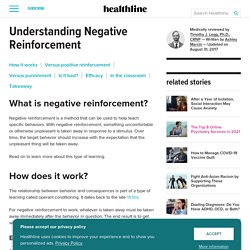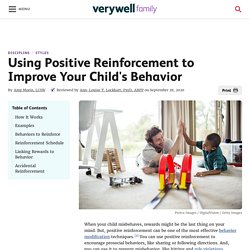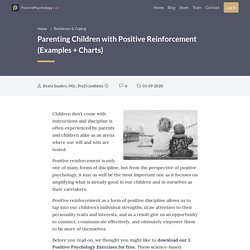

Understanding Reinforcement vs. Punishment – Parenting With Psychology. I simply cannot blog another week without covering reinforcement and punishment.

These are terms you have probably heard before and you may have a thorough understanding of them or an inkling about what they mean, but they are critical to parenting so let’s spend some time refreshing your memory. The quick psychology history lesson is that these terms are part of B.F. Reinforcement and Punishment.
Learning Objectives Explain the difference between reinforcement and punishment (including positive and negative reinforcement and positive and negative punishment)Define shapingDifferentiate between primary and secondary reinforcers In discussing operant conditioning, we use several everyday words—positive, negative, reinforcement, and punishment—in a specialized manner.

In operant conditioning, positive and negative do not mean good and bad. Instead, positive means you are adding something, and negative means you are taking something away. Reinforcement means you are increasing a behavior, and punishment means you are decreasing a behavior. Using Reinforcement and Punishment at Home. Negative Reinforcement: What Is It and How Does It Work? What is negative reinforcement?

Negative reinforcement is a method that can be used to help teach specific behaviors. With negative reinforcement, something uncomfortable or otherwise unpleasant is taken away in response to a stimulus. Over time, the target behavior should increase with the expectation that the unpleasant thing will be taken away. Read on to learn more about this type of learning. Parenting A Teen Through Positive Reinforcement - Back On Track. Most parents can agree: the teenage years can be rough!

Hormones are raging, they are trying to gain more independence, and they spend a lot of time away from their parents and their home while hanging with friends. One minute they love and adore you, the next minute you ruined their life. Using Positive Reinforcement to Improve Behavior. When your child misbehaves, rewards might be the last thing on your mind.

But, positive reinforcement can be one of the most effective behavior modification techniques.1 You can use positive reinforcement to encourage prosocial behaviors, like sharing or following directions. And, you can use it to prevent misbehavior, like hitting and rule violations. Negative Reinforcement: What Is It and How Does It Work? What is Negative Reinforcement? Negative Reinforcement.
Parenting Children with Positive Reinforcement (Examples + Charts) Children don’t come with instructions and discipline is often experienced by parents and children alike as an arena where our will and wits are tested.

Positive reinforcement is only one of many forms of discipline, but from the perspective of positive psychology, it may as well be the most important one as it focuses on amplifying what is already good in our children and in ourselves as their caretakers. Positive reinforcement as a form of positive discipline allows us to tap into our children’s individual strengths, draw attention to their personality traits and interests, and as a result give us an opportunity to connect, communicate effectively, and ultimately empower them to be more of themselves. Before you read on, we thought you might like to download our 3 Positive Psychology Exercises for free. Positive Reinforcement - Tips for teaching and parenting. Positive and Negative Reinforcement and Punishment.
POSITIVE AND NEGATIVE REINFORCEMENT 4 Examples of Negative ... 3 behavioral techniques for educating children: reinforcement, punishment and extinction. Tantrums, crying, screaming, biting, hitting … When it comes to parenting, sometimes we don’t really know how to stop inappropriate behavior.

But behavioral techniques can help us to control these and other behaviors. They will also help us to encourage what we consider appropriate behavior. As you can imagine, it will take some effort on our part, but once it gets under way, we’ll see remarkable results … Read on for useful behavioral techniques you can use with your children! “Education is not preparation for life; education is life itself”. -John Dewey- The Study of Punishment in Psychology. Punishment is a term used in operant conditioning to refer to any change that occurs after a behavior that reduces the likelihood that that behavior will occur again in the future.

While positive and negative reinforcements are used to increase behaviors, punishment is focused on reducing or eliminating unwanted behaviors. Punishment is often mistakenly confused with negative reinforcement. The difference: Reinforcement increases the chances that a behavior will occur and punishment decreases the chances that a behavior will occur. 10 Positive Punishment Techniques & Their Effect.
By: Ashley Brown Updated February 11, 2021 Medically Reviewed By: Laura Angers.

Positive Punishment: What Is It And How It Works? - MomJunction. Positive punishment!

Sounds like a perfect oxymoron. But how can a punishment be positive? Punishment: 5 Negative Consequences. Today we are going to look further into the idea of using punishment and the 5 negative consequences that can follow. In my last article, I mentioned that the goal of discipline is to lead, guide, and direct kids towards pro-social behaviors. In contrast, punishment tells kids what to avoid and what not to do, or they will experience some form of pain! To better understand the negative consequences of punishment, let’s take a brief look at Joey’s story from last week’s article: It was a hot summer day, and Mom was excited to take her two young boys to the beach.
About mid-day, six-year-old Joey started throwing sand at his brother. How Negative Punishment Works. Negative punishment is an important concept in B. F. Skinner's theory of operant conditioning. In behavioral psychology, the goal of punishment is to decrease unwanted behavior. Negative Punishment: Definition.
What is Negative Punishment (Examples and Effectiveness) In this article, we will review negative punishment, its definition, examples, and drawbacks. American psychologist B.F. Skinner developed the theory of operant conditioning, which stated that a person or animal’s behavior could be increased or decreased by adding or removing appropriate stimuli after the behavior is exhibited. The difference between classical conditioning and operant conditioning is that classical affects unconscious behavior, while operant affects conscious behavior. Within operant, punishment aims to reduce a behavior while reinforcement increase a behavior. Punishment or reinforcement can be positive or negative. Positive Punishment: What Is It And How It Works? - MomJunction. Discipline Kids With Positive and Negative Consequences. When most parents think about consequences for kids, they usually envision negative consequences, like a time-out or taking away a video game.
While negative consequences are instrumental in changing a child's behavior, positive consequences are also effective discipline tools. When used together, positive and negative consequences will change your child's behavior1 —as long as they are used consistently. Use positive consequences to reinforce good behavior and enforce negative consequences to discourage bad behavior. How Consequences Work Every choice you make leads to either positive or negative consequences.
10 Positive Punishment Techniques & Their Effect. 3 Examples of Positive Parenting in Practice. Do you like the idea of positive parenting but not sure how to put into practice in every day interactions? Like most families, in my home there are moments that are challenging. Sometimes what my children want, and I what I expect are not necessarily in agreement.
Reinforcement vs. Punishment: Changing Behavior. Reinforcement vs Punishment Psychology [Examples] Reinforcement Vs. Punishment for Kids (And Examples) Punishment vs reinforcement: Getting the behavior you want from your kids - FamilyToday. Positive Reinforcement vs Positive Punishment for Kids: Types & Examples. Using Reinforcement and Punishment at Home. Reinforcement Vs Punishment parents.